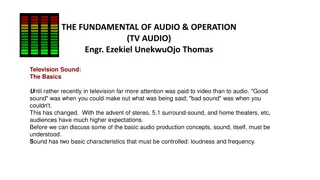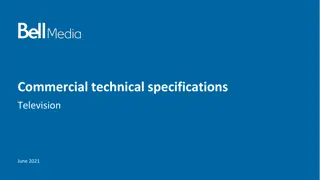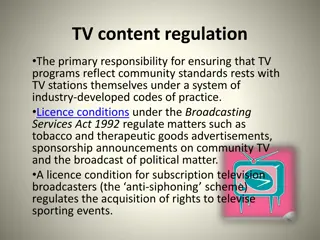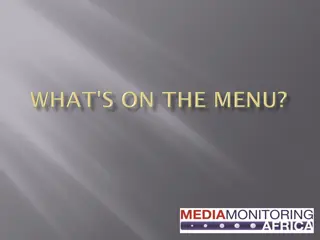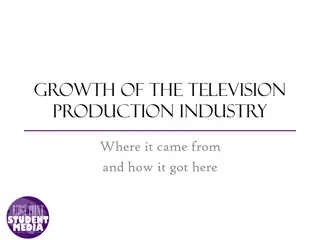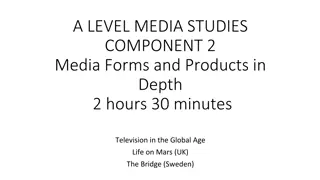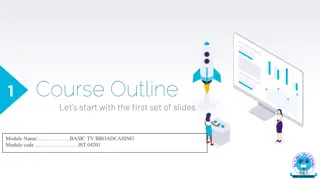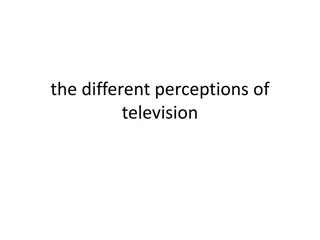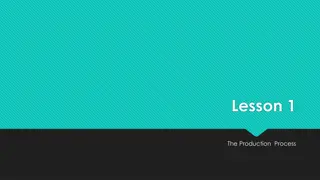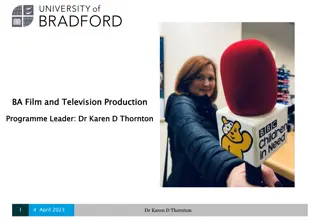The Importance of Pre-Production in Television Program Production
The process of producing a television program is divided into three stages: Pre-Production, Production, and Post-Production. Pre-Production is vital as it involves setting goals, planning, and decision-making, which ultimately lead to smoother production and editing processes. Planning saves time, ensures a focused program, and helps in anticipating and resolving problems. Fundamental decisions, audience analysis, goal-setting, content planning, and format selection are crucial aspects of effective pre-production.
Download Presentation

Please find below an Image/Link to download the presentation.
The content on the website is provided AS IS for your information and personal use only. It may not be sold, licensed, or shared on other websites without obtaining consent from the author. Download presentation by click this link. If you encounter any issues during the download, it is possible that the publisher has removed the file from their server.
E N D
Presentation Transcript
pre pro post pre pro post- -production production
Chapter 2: Pre-Production The Three Stages of Production The process of producing a television program is generally divided into three stages. The first stage, PRE-PRODUCTION, includes but is not limited to: Setting goals, writing program proposals, conducting program conferences and crew meetings, story-boarding and scripting, location scouting, gathering all equipment and supplies needed, etc. The second stage, PRODUCTION, refers to the shoot itself, and includes all aspects of cleaning up afterwards and crew debriefing. The final stage, POST-PRODUCTION, refers to editing the material shot during production, and should also include distributing the program and promoting it to your target audience. All of the stages are important; but pre-production is especially important because it makes the other stages proceed that much more easily and smoothly. The Importance of Planning (Pre-Production) Let s be honest: Access producers have lives outside of television, and they re frequently looking for shortcuts. Many producers think that they can save time and energy by skipping pre-production and moving right into production. This is not true. You cannot avoid pre-production; you can only postpone it. Pre-production is in many respects another word for decision- making. And you cannot avoid making decisions, only postpone the inevitable. And when you postpone making important decisions until the last possible minute (i.e. until you re just about to shoot or edit), you re putting extra pressure on yourself at the time when you are already under the pressure of the clock to get something shot or edited. Don t make this mistake. Planning offers many advantages: * Planning saves time (your precious time, the crews and talents time, and the costly equipment time) * Planning makes the shoot go more smoothly * Planning makes for a more focused, better executed program * Planning keeps you sane, because it allows for you to anticipate, plan for, and deal with the problems that inevitably come up. So what kind of planningdo you need to do?
Make Fundamental Decisions: Set Your Goals Before you begin to produce a program, you must answer a number of fundamental questions regarding... Who am I trying to reach? What is the best way to reach this audience? Why am I making this production? What is the purpose of the production? What do I want my audience to think, feel, or do as a result of seeing it? Is video the right tool for the job? AUDIENCE: GOALS: As an Access producer, you have almost complete freedom to do whatever kind of show you want, about whatever topic you want, in any manner that you want (subject to city, state, and federal law, of course). This means you don t have to mimic conventional commercial television. Be innovative. Be creative. Be funky. Be whatever. But if you can do anything, how do you decide what to do? Start with a very clear understanding of your audience and your goals. If you figure those things out, figuring out the format and content becomes a whole lot easier. And it makes you much more likely to create a program that succeeds in the way you hoped it would. Plan Your Content To figure what information to communicate through your program, you should do two things: Research the topic. Know your material. List the most important points to get across. - Prioritize them. - Don t try to squeeze too much information into the program. Less is sometimes more. Decide on Format Knowing what audience you re trying to reach and what information you re trying to communicate makes it easier to figure out how to communicate that information. Ask yourself: What kind of form will the program take (documentary, talk show, news, theatrical, feature, live, interactive, etc )? What should it look and feel like? Think visually and aurally. If there are other shows that it should resemble, how are those programs structured? What should happenfirst, second, third, , last?
Put Your Vision on Paper Write a Treatment In the classic days of Hollywood, when an executive first learned of a possible production, it was presented in the form of a treatment. The purpose of the treatment was to show the executive how the story would be treated - hence the term treatment. The person who wrote it would, of course, tailor it to be as attractive as possible for that executive. Hence, the treatment is not the original story itself, but a description of how it will look as a moving picture. A treatment should serve as a very brief summary of who your audience is, what you want them to get from watching your program, and how you propose to accomplish that goal. Here s an example: I plan to do a 3-minute program showing the general public how to get to CCTV s Central Square facility using public transportation. The camera will be the eye of the public and the purpose of the program is to visually show and tell how easy it is to get to CCTV. Write a Script While the treatment is necessarily brief, the script can be any length, depending upon its purpose and the amount of detail you include. Scripts can serve any number of several important purposes: Making sure that the program keeps to its intended purposes Giving the director and/or camera person a clear roadmap as to the producer s intentions Making sure that the rest of the production team, including the talent, knows exactly what to do and when. Scripts can take any number of forms, including: A list of points to be made, questions to be asked, and/or specific images to capture Side-by-side columns describing the audio and video that will be recorded during every minute of the program.
A visual STORYBOARD which captures in quick sketches the sequences of images to be shot, with the corresponding audio written in captions underneath. Don t be put off by thinking that only artistic types should do storyboards. Storyboards aren t used to showcase artistic talent, but to help you pre-visualize your shots and identify effective, appropriate shot sequences. The video portion of the script will help comprise your list of what to shoot, your Shot Sheet. Here are some tips about writing scripts, from the Somerville Com- munity Access Handbook, by Carol Yourman and Abigail Norman: Know your audience, and keep your objectives in mind. Write to your audience; keep your representative viewer in mind. Think visually and aurally. Keep simple, direct, and to the point. Be conversational. Avoid a formal, term-paper style. Avoid long, complex sentences. If your script has spoken lines, speak them aloud before committing to paper. Use a word processor if you can, and don t be afraid to revise. Communicate frequently with your director, producer, talent, and other colleagues.
Make A Shot Sheet Nothing will teach you more about good camerawork than your first session editing footage that you've shot. Still, here s some good advice for anyone starting out. Good planning and scripting is one key to successful shooting. Your editing job will be much, much easier and go much faster if you figure out exactly what shots you need to get before you ever start shooting. That s what scripts and storyboards are for! But even if you skip those things, don t leave home without a Shot Sheet. The shot sheet will remind you of all the footage you need to capture during the production, so that you come back to the edit suite with everything needed to finish your program. And when making up your shot sheet, don t forget to include all of the cut- aways, cut-ins, and reaction shots you ll want to capture. (See Chapter 4, Fundamentals of Camerawork and Shot Composition, for more information about these kinds of shots.) Also be sure to include audio segments in your shot sheet. Will you need extra ambient sounds to fill in those silent parts of your tape, special sound effects, or music? Decide Shooting Locations Your planning and scripting will probably call for you to shoot your program in specific locations. On the other hand, some access producers find that they end up making some decisions for reasons that have little to do with what the program calls for and much more to do with the realities of their limited resources of people, time, and energy. For this reason, it may help to review the nature of working in the Field vs. working in the Studio; these two environments are very different from each other and offer particular advantages and disadvantages. Your decision on where to shoot may depend, in some instances, on these differences. Keep in mind, however, that many programs combine elements shot in both locations, capitalizing on each environment s advantages.
Advantages Disadvantages Studio Convenience & Control: Staging: Plenty of power, lighting, audio gear Little likelihood of interruption TV stage looks artificial and may not relate to program content Don t have to deal with picking up and moving lots of equipment Functionality: Functionality: Studio is a confined space 3-camera set-up enables you to shoot from multiple angles in one take What you shoot, whether live or live-on-tape, is what you get Can be live and interactive Creative options with chroma People: key Need large crew, typically at least six, some of whom must have advanced certifications Time: Little or no editing time is needed for programs shot live-on-tape Support: CCTV Staff are on hand to deal with technical issues Staging: Field Convenience & Control: Field footage is often more compelling, naturalistic, and related to the program content Not as controlled a setting as the Studio in terms of lighting, audio, staging, and power More likelihood of interruption Have to deal with picking up and moving lots of equipment Functionality: You can shoot anywhere you want. Functionality: Pre-recorded nature of the program allows you to edit it as desired Live and/or interactive telecasts not usually possible Cannot do chroma key or other special effects available with studio equipment People: Generally need only a small crew Time: Your program usually requires editing after shooting Support:
Keep in mind that while the environment of a STUDIO SHOOT is generally constant and predictable, the environment of the FIELD SHOOT is always variable. The studio provides warmth in winter, air conditioning in summer, easily controlled lighting and audio as well as many other aspects that the producer and director can always count on. When one enters the ever-changing environment of the field, however, one should always expect the worst and hope for the best. On the minus side in the field, expect: Audio problems: Video problems: Traffic noises, phones ringing, conversations Glaring sunlight, backlighting, color temperature conflicts Too few A/C outlets, blown fuses, dead batteries Wind, rain, sleet, snow, icebergs (just the tip of) Gesturing pedestrians, uncooperative security Flat tires, forgotten equipment Power problems: Weather problems: People problems: Logistics problems: On the plus side, you can shoot all those things you could never shoot in the studio: Cars, planes, trains, the ocean, a skyscraper, birds, parades, concerts, fires, to name just a few. In addition, you can present your subject, both aurally and visually, in a far more naturalistic and compelling way than you could ever do in the studio. Crew & Time Requirements: The most critical constraint you will face as an Access producer is probably time - your time, your crew s time, and your talent s time. Whereas a Studio shoot typically requires a technical crew of at least six people, most single-camera productions in the field require only one or two technical people: A cameraperson and audio engineer. On the other hand, while a single 3-hour shooting session in the Studio may be all that s needed for completing a one-hour program, many single-camera productions in the field require you to spend many hours in the edit suite. Professionals allot up to one hour of editing time per one minute of finished program; Public Access producers often invest much less time, perhaps one hour of editing time for every five minutes of finished show. So your choice of shooting location may depend, sometimes anyway, on whether your own time is limited or not, and whether or not you ll be able to get a whole bunch of people together for a few hours. If you think you ll be producing a Studio shoot in the future, you should use every chance now (including taking classes and volunteering on other people s shoots) to get to know as many people as you can who might be able to help you out later on.
Put Your Plans on Paper There s a lot to do, and most people prefer not to try and keep it all in their head. Make a list of everything you need to do. Create a timetable: What are you going to do this week, next week, the week after? has to happen by the third week, what do you have to do before then? Remember that you have many other responsibilities in your life, so be realistic. If something Make All the Arrangements Do initial paperwork a) Submit a Program Production Contract to CCTV at least one week prior to reserving equipment. b) Get signed Premises Taping Release (if not shooting in the Studio). Accessibility is always an issue in the field. Before videotapingat a location in the field (at the Mall, for example), you must obtain written permission from the property owner or manager. When videotaping on public property, it is often a good idea to get the permission of the local government and police authorities. Communicate closely with event coordinators a) If shooting an event, obtain a script of the program. Plan shots and transitions between shots. b) If you want to have input into the staging, lighting, audio, and program outline decisions, insert yourself into the decision-making process as early as possible. Don t wait til the day of the shoot, when the plans have already been made, and the group you re shooting for will be least likely to be accomodating. Arrange for talent a) Prepare them for what will happen during shoot. b) Ask them if they have photos, music, objects that would enhance the production. c) Tell them how to dress for television, and what clothes to avoid. (See Chapter 7, Fundamentals of Being Talent, for more information.) d) Make sure they know how to get to the shoot and when to arrive. Arrange for crew a) Make sure they re certified to use the equipment. b) Prepare them for what will happen during shoot. c) Make sure they know how to get to the shoot and when to arrive (early to help you set up, right?).
Scout the Location A site survey conducted in advance of your shoot helps you anticipate all of the problems that may occur and prepare accordingly. Ideally, you would conduct the survey at the same time of day as the shoot so that you re not surprised by a church bell ringing, reflected sun, locked door, etc. Power: a) Where are the outlets located? b) Are the sockets grounded(three-prong) or not (two-prong)? c) How many extension cords do you need? d) Where is the circuit breaker box located? Lighting: a) What are the lighting sources in the environment? b) Can you take advantage of indirect lighting by bouncing light off walls? c) Will you need to bring additional lighting? Will they allow you to? If you do, will it blow the fuses? Do you have the room to set them up? Will you need sandbags to keep the light stands from being knocked over? Will your talent be uncomfortable? d) How are you going match the color temperature of all the lights? e) Are you going to have back-lighting or reflection problems? f) Do you have enough AC power for the lights and the other equipment? (Here s how you can tell: Amps x volts = watts. Most places run on 120 volts, so if the circuit you re on is rated at 15 amps, then you may plug in up to 15 x 120 = 1800 watts of gear on that circuit.) Audio: a) What ambient noises (such as phones ringing, air conditioners, refrigerators, traffic or construction noise, conversations in another room) will you have to contend with? b) Will it be noisy and difficult to mic? Do you need a windscreen? c) Is there a public address or sound system from which you can take a feed? Does it give a line- or mic-level feed? What kind of connectors does it have? How far is it to your recording device? d) If using wireless mics or intercoms, have you tested them in that environment to insure there will be no interference? Set: a) What environment will you be shooting in? b) Do you need to re-arrangefurniture for any reason? c) What will be in the background, and what can you put in the background that would be more appropriate? d) What props do you need to bring with you?
Cameras: a) Where can you put the cameras for the best shots and still not interfere with the audience? b) What types of shots and angles can you get from these positions? c) How far is it from these positions to the power and audio sources? People: a) Who are the people you need to know (people in charge, people with keys, secretaries, janitors, security)? Logistics: a) What time can you gain access to the location? b) Will you have enough time to set up? c) Where can you park for unloading and loading? d) How long will it take you to get there? e) Where can you run all your cables so that they won t be walked on or tripped over? Do you need to tape down the cables with gaffer s tape? f) Do you need to take crowd control measures - such as installing no parking signs, roping off areas, locking doors, or hiring off-duty police? g) Where is the nearest telephone you may use to call CCTV, your talent, your crew? h) If doing a live shoot, where are the cable drops for sending the signal upstream and watching the return signal? Make an Equipment List Make a list of all the equipment you ll need. You ll use this list when reserving CCTV s facilities, and later on before heading off to the shoot. Don t forget things like set supplies, raw videotape, any pre-edited (roll-in) footage you plan to use, duct tape, pen and paper, tweeker, etc. Do the Follow-up Paper Work a) Reserve CCTV s facilities and equipment. You ll need an approved production contract number, which you should receive within five business days of submitting a Production Contract. b) Get signed talent releases from all performers and participants. If minors, get signatures from their parents or guardians. Reconfirm All Your Arrangements. It s not enough to recruit crew and talent, you have to get them to show up, too! Many producers have learned from experience to give their crew members and talent a reminder call a day or two before the shoot. It s also a good idea to reconfirm your equipment request with CCTV. Get a Good Night s Rest. Have a Good Shoot!
Forms: Pre-Production Check-list Make Fundamental Decisions Define Your Audience. Define Your Goals. Research the Topic. List the Most Important Points to Get Across. Prioritize Them. Decide on Program Format. Put Your Vision on Paper Write a Treatment. Write a Script and/or Storyboard. Make a Video and Audio Shot Sheet. Decide Shooting Location Put Your Plans on Paper Make a List of Everything That You Need to Do, and A Timeline. Make All the Arrangements Do the Initial Paperwork: Submit Production Contract, Get Signed Premises Taping Release for Owner and/or Police and government. Communicate Closely with Event Coordinators. Arrange for Talent. Arrange for Crew. Scout the Location Do a Site Survey. Take a List of Everything to Check Out. Make an Equipment List. Make a List of All the Equipment You ll Need. Do the Follow-Up Paper Work Reserve CCTV s Facilities and Equipment. Get Signed Talent Releases from All Performers (or guardians). Reconfirm All Your Arrangements Give Reminder Calls to Your Crew and Talent. Reconfirm Your Arrangements with CCTV and Event Coordinators. Get A Good Night s Rest
Forms: Location Survey Location: Address: Floor: ContactPerson: Room Number: (name) (phone) Name of Janitor/Maintenance: Phone: What time will space be accessible for set-up? Location: Electricity # of AC Outlets: 3 or 2 prong? (indicate location of outlets on diagram below) # of Extension Cords: # of Amps: Location of Fuse/Circuit Breaker Box: # of Power Strips: Breakers or Fuses? Audio Is there a public address or sound system? Does it have mic or line feed? What type of connectors are needed to take a feed from the sound system? _ Any ambient noises? If using wireless mics or intercom, did you test them? Lighting Will you have enough available light? What type of light is it? Is portable lightingneeded? How many lights? Set What will be in the background? Do you need to rearrange furniture? What props do you need to bring? Do you need to limit access to any doors or areas?
Diagram of space, including windows, locations of outlets, and possible camera and portable light locations: Logistics How long will it take you to get there? Where can you park? Loading Dock? Ceiling height: Width of Hallways: Sprinkler System? Type of Flooring: Permits and clearances needed: Elevator or stairs? Widthof Doors: Location of nearest phone you can use? Receive calls? Phonenumber:
Forms: Equipment Inventory Program: Date of Shoot: Location: Crew Call Time: Transportation Vehicle: Permits: Parking/gas money: Paperwork Premises Taping Release: Talent Release Forms: Script & Shot Sheets: Labels for Tapes: Camera Equipment Camera/Camcorder/AC Adaptor: Fully ChargedBatteries: VCR/Cables/AC Adaptor: Monitor/Cables: Tripod: Cases/Bags: Videotape: Audio Gear Microphones/Windscreens: AudioMixer: Fully ChargedBatteries: Headphones: Cables: Adaptors: Gaffer s Tape: Lighting Light Kit and Stands: Extra Lamps: ReflectiveCards: Corrective Colored Gels: Diffusion: AC Power Extension Cords: Power Strips: 3-2 Prong Adaptors:
Forms: Talent Release Name: Program Title: Authorization and Release In return for the opportunity to appear in the above named program, I hereby grant to producer, permission to transmit live and/or to record for later transmission my likeness and/or voice as a part of the above-named cable television access program, for any lawful purpose, at any time. I also authorize the use of my name and any excerpts of said program for the purpose of promoting and publicizing that program. I waive any right that I may have to inspect or approve the finished product or the written copy that might be used in conjunction therewith, or the use to which it may be applied. I agree to hold the producer, Cambridge Community Television, MediaOne of Cambridge, and any cable company which transmits the program harmless for any liability to others arising from anything I may say or do during the program, except as set forth in a written script provided to me by the program producer. , cable access I have read this agreement before signing and fully understand its contents. Signature: Print Name: Print Address: Signature of Parent or Guardian if above-named person is not of legal age Forms: Storyboard Date







